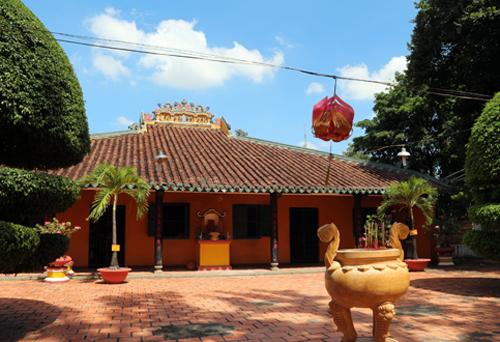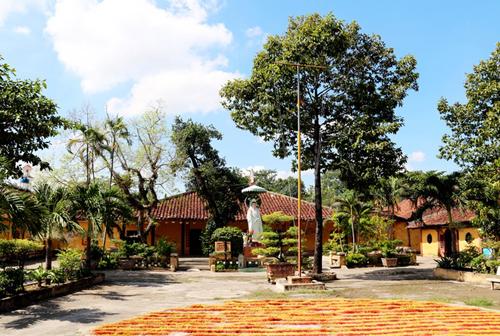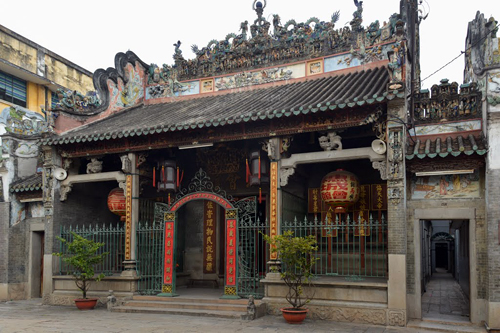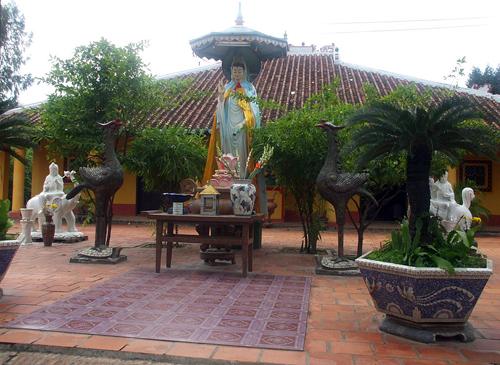|
The five oldest Buddhist temples in Saigon
To Dinh Giac Lam, Hue Nghiem, Giac Vien
are pagodas of over 200 years old, which are closely associated with the
formation and development of Saigon.
Hue Nghiem

Hue Nghiem Pagoda is located in Dang Van Bi Street (Thu
Duc District). Today, the temple is often called the Hue Nghiem 1 Pagoda to
distinguish from the Hue Nghiem 2 in District 2.
The temple was established by Zen master Thiet Thuy –
Tanh Tuong (1668 -1757) in the eighteenth century. Some ancient documents
said the temple was built in 1721. Hue Nghiem is the oldest pagoda in Ho Chi
Minh City today.
Initially the temple was built in the lowlands, about
100 meters from the current pagoda. Ms. Nguyen Thi Hien (1763-1821) donated
her land to rebuild the temple. The temple was restored many times.
Thelast time was in late nineteenth century by Zen Master Dat Ly – Hue
Luu.
Its architecture was also changed after the restoration
in 1960, 1969, 1990 and 2003. The temple campus is quite wide, with many
ancient towers.
Giac Lam Pagoda

Giac Lam is one of the oldest pagodas in Ho Chi Minh
City. Originally, it was built by Ly Thuy Long – a native Minh Huong, in
1744, as a gathering place during Lunar New Year. The newly built temple was
a scenic lookout overlooking Gia Dinh Market while the area was still
undeveloped and quite like a jungle. The name Giac Lam was given to the
pagoda after the arrival of Monk Thich Lam Quang of the Lam Te Zen lineage,
in 1772. After many times of renovation and reconstruction, it’s now located
at 118 Lac Long Quan Street, Tan Binh District. Local people also call it Cam
Son or Cam Dien Pagoda.
“The Third” structure of Giac Lam Pagoda is also
typical of southern pagodas. It means the pagoda consists of three main
buildings: the main ceremonial hall, the dharma preaching hall and the meal
hall.
The first one is big with many huge pillars engraved
with meaningful sentences. It worships many Buddhas such as Buddha Amitabha,
Buddha Shakyamuni and some Bodhisattva like Maitreya Bodhisattva,
Samantabhadra Bodhisattva and Avalokiteshvara Bodhisattva. Giac Lam Pagoda
has 118 statues made of wood, bronze and cement.
Most of them are very ancient and valuable, which
demonstrate the development of Vietnamese art of sculpture in 18th century.
Not only is Giac Lam a place to observe traditional southern structure of
pagodas, but it’s also where tourists can discover the specific cultural
characteristics of Vietnam, like the 4-season fruit pattern.
In front of the pagoda is a big bodhi tree, a gift from
the great Sri Lankan monk Narada in 1953, accompanied by the arrival of a
sample of the relics of Gautama Buddha. With the purpose to store these
relics, a seven-storey high stupa was built in 1970 under the architectural
plans of Vinh Hoang. Due to wars, the construction was put off and could only
be finished in 1993. Today, the east-facing, hexagonal-shaped stupa is
considered a landmark, being the tallest Buddhist tower in the city.
Giac Vien Pagoda

Located at number 161/85/20, Lac Long Quan Street,
District 11, Giac Vien is one of the oldest temples in Ho Chi Minh City. At
first, it was only used as a warehouse while another pagoda (named Giac Lam)
was being rebuilt. After the renovation of the latter was completed, Giac
Vien Pagoda was extended as a thatched-roof hut used for worshipping
Bodhisattva and was named Kwan-Yin. Finally, it became a pagoda in 1850,
thanks to the monk Hai Tinh Giac Vien.
People said that Emperor Gia Long of Nguyen Dynasty
used to worship at Giac Vien, known as the centre of Buddhism of six southern
provinces in 19th century. Originally constructed in 1789, this pagoda
underwent major restorations in 1899 and 1910. Today, it still preserves many
Buddhist printing inscriptions of considerable value.
The pagoda’s style, decoration and arrangement of the
worshipping shrines followed the typical ancient of pagodas built under
Nguyen Dynasty of the 19th century, as well as of southern area. Because of
its history, Giac Vien’s structure is similar to that of Giac Lam’s, with the
main big sanctuary to worship Buddha, two corridors to the east and west to
prepare and a spacious compartment at the rear.
Tourists should pay attention to the 60 wooden
engraving plates, each of them illustrating different symbols of Vietnamese
culture and daily life. They are the only ones that have been
perfectlypreserved in Vietnam.
Chua Ba Thien Hau Pagoda

The Chua Ba Thien Hau Pagoda (The Pagoda of the Lady
Thien Hau) is a Chinese style temple located in Nguyen Trai Road. It is
dedicated to Thien Hau, the Lady of the Sea, who is also known as Mazu.
Thien Hau is a deity of traditional Chinese religion,
who is revered in the southern maritime provinces of China and in overseas
Chinese communities. She is not specifically a deity of Taoism or Buddhism,
though she has been brought into connection with figures and themes from
Taoism and Buddhism.
Thien Hau is revered by seafaring cultures as she has
the ability to travel over sea, by mat or cloud, to protect or rescue
stranded seafarers and fishermen. The pagoda, one of the oldest of Chinese
community in Ho Chi Minh City, was built iaround 1760, then restored in 1800,
1842, 1882, 1890 and 1916. Many of the materials used for constructing the
pagoda were brought from China.
The interior of the temple is a partially covered
courtyard, at the end of which is the altar to Thien Hau, where stand three
statues of the goddess. The faces of the statues are bronze in color, and the
clothes and crowns are multi-colored. The exposed portions of the courtyard
contain incense burners, and give a view of the remarkable porcelain dioramas
that decorate the roof. The dioramas show scenes from a 19th century Chinese
city, and include such colorful figures as actors, demons, animals, and
Persian and European sailors and traders. One scene depicts three Taoist
sages representing longevity, fecundity and prosperity.
Suspended over the main worship area, in front of the
altar of Thien Hau, are dozens of incense coils. Visitors to the temple
frequently purchase these, attach their names to the coils, and then have
them hung from the ceiling of the temple. As the incense smoke curls upwards
in the air, the pilgrims believe their prayers are transmitted to the deity.
Many of the incense coils are quite large, with a diameter of more than a
meter, and can burn for several weeks.
The festival of worshipping Thien Hau on the 23rd day
of the 3rd month of Lunar year is one of the most popular annual festivities
of Chinese people in Vietnam.
Phung Son Pagoda

Phung Son Pagoda is located at 1408 Duong 3 Thang 2,
District 11, Ho Chi Minh City.
Phung Son Pagoda was established in the early 19th
century by Bonze Lieu Thong. Since then, it has undergone two major
restorations. Many statues found in the pagoda were created by a group of
craftsmen from Sa Dec.
Many years ago, it was decided that it should be moved
to a different location. All of the ritual objects were loaded on to the back
of a white elephant for transportation.
On the way to the new site, the elephant slipped and
all of the precious objects fell into a nearby pond. This event was
interpreted as a sign that the pagoda should remain at its original location.
All of the ritual objects were retrieved, except the
bell, which locals say was heard ringing whenever there was a new or full
moon up to a century ago.
A number of valuable statues, such as Di Da Tam Ton,
Ngu Hien Thuong Ky Thu, a stone statue of Buddha covered with gold leaves,
and a ceramic statue of Tieu Dien are also found in the pagoda.
The surrounding area is an archaeological site from
where many artifacts were excavated, such as a baked earthen head statues and
ceramic items belonging to the Oc-Eo culture.
The Ministry of Culture has recognized the pagoda as a
historical and cultural relic.
People pray three times a day from 4 to 5 am, 4 to 5
pm, and 6 to 7 pm.
Compiled by Pha Le, VNN
|
Thứ Bảy, 12 tháng 3, 2016
Đăng ký:
Đăng Nhận xét (Atom)
Không có nhận xét nào:
Đăng nhận xét